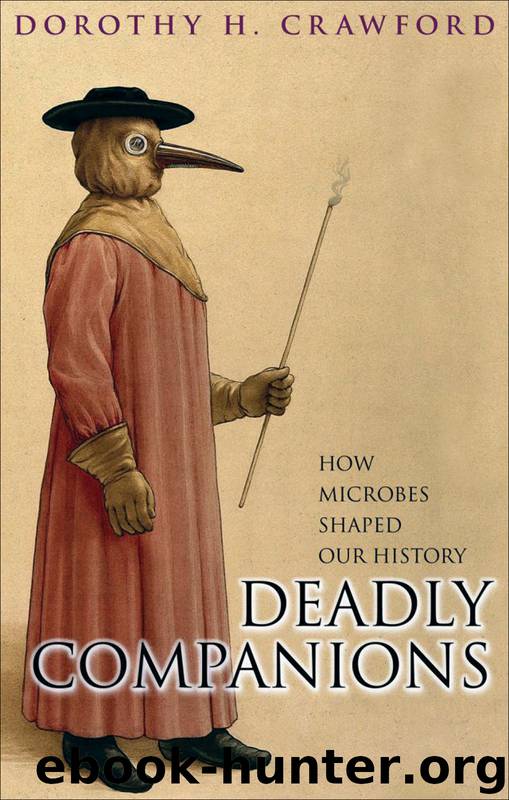Deadly Companions by Dorothy H.; Crawford

Author:Dorothy H.; Crawford [Crawford, Dorothy H.;]
Language: eng
Format: mobi
Publisher: OUP Oxford
Published: 2007-03-15T04:00:00+00:00
Figure 5.1 Title page from Bartholomew Steber’s Syphilis, 1497 or 1498
The cause of these impediments or infyrmytes doth come many wayes, it maye come by lyenge in the sheets or bedde there where a pocky person hath the night before lyenin, it maye come with lyenge with a pocky person, it maye come by syttenge on a draught or sege where as a pocky person did lately syt, it may come by drynkynge oft with a pocky person, but specially it is taken when one pocky person doth synne in lechery the one with another.11
Syphilis is caused by the highly motile, corkscrew-shaped spirochaete bacterium, Treponema pallidum, that is transmitted either sexually or from mother to unborn child through the placenta. In adults the first sign of the disease is a relatively painless genital ulcer, or chancre, from which the microbe accesses the bloodstream and invades internal organs. This produces the symptoms of secondary syphilis, including fever, enlarged glands, skin rashes and mouth and genital ulcers, all of which resolve in a few weeks. Then begins a latent period of up to twenty-five years during which the microbe hides away but continues to grow, producing internal ulcers called gumma, that slowly and inexorably destroy the surrounding tissues. At the same time the microbe may invade blood vessels and the brain, causing the array of problems of tertiary syphilis that include heart attacks, strokes, blindness, deafness, personality changes and loss of intellect. T. pallidum is penicillin sensitive so these days the disease can be cured in its early stages, but the tissue destruction of the later stages is, of course, irreversible.
No one disputes the fact that the arrival of syphilis in Europe coincided with the return of Columbus’s men from Hispanola in 1493, but whether the two events are connected is hotly debated. The traditional story tells of T. pallidum disembarking with the sailors in Lisbon, and there was no doubt in the mind of Ruy Diaz de Isla, the Spanish physician who treated Alonso Pinzon, captain of the Pinta, and some of his crew on their return, that this was the case. He later wrote:
Download
This site does not store any files on its server. We only index and link to content provided by other sites. Please contact the content providers to delete copyright contents if any and email us, we'll remove relevant links or contents immediately.
| Administration & Medicine Economics | Allied Health Professions |
| Basic Sciences | Dentistry |
| History | Medical Informatics |
| Medicine | Nursing |
| Pharmacology | Psychology |
| Research | Veterinary Medicine |
Periodization Training for Sports by Tudor Bompa(7916)
Why We Sleep: Unlocking the Power of Sleep and Dreams by Matthew Walker(6352)
Paper Towns by Green John(4790)
The Immortal Life of Henrietta Lacks by Rebecca Skloot(4253)
The Sports Rules Book by Human Kinetics(4077)
Dynamic Alignment Through Imagery by Eric Franklin(3919)
ACSM's Complete Guide to Fitness & Health by ACSM(3823)
Kaplan MCAT Organic Chemistry Review: Created for MCAT 2015 (Kaplan Test Prep) by Kaplan(3799)
Introduction to Kinesiology by Shirl J. Hoffman(3624)
Livewired by David Eagleman(3534)
The River of Consciousness by Oliver Sacks(3417)
The Death of the Heart by Elizabeth Bowen(3335)
Alchemy and Alchemists by C. J. S. Thompson(3294)
Descartes' Error by Antonio Damasio(3164)
Bad Pharma by Ben Goldacre(3094)
The Emperor of All Maladies: A Biography of Cancer by Siddhartha Mukherjee(2928)
The Gene: An Intimate History by Siddhartha Mukherjee(2927)
The Fate of Rome: Climate, Disease, and the End of an Empire (The Princeton History of the Ancient World) by Kyle Harper(2869)
Kaplan MCAT Behavioral Sciences Review: Created for MCAT 2015 (Kaplan Test Prep) by Kaplan(2815)
